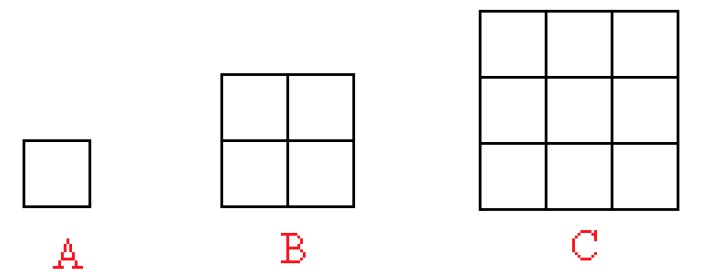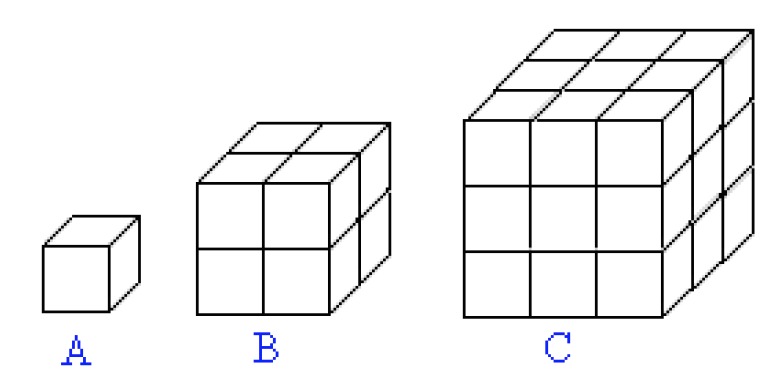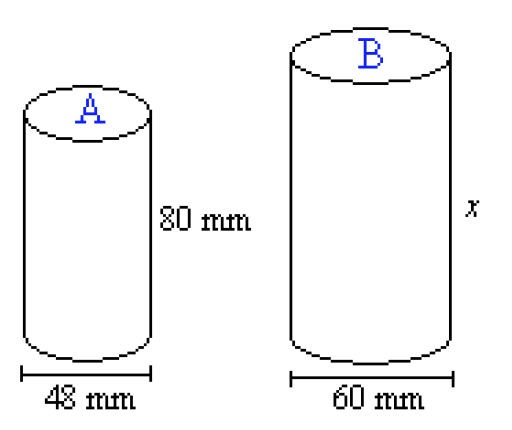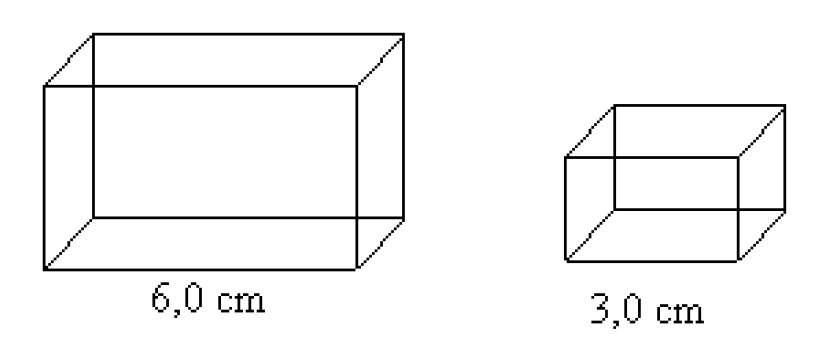15. Areas and volumes of similar objects
Areas and volumes of similar objects
The three squares are formed of similar patterns. Their length ratio is [[$ 1: 2: 3 $]], whereas their area ratio is [[$ 1: 4: 9 $]].

There is a relationship between length and area ratios. Area ratios can be written using length ratios as follows: [[$ 1^2 : 2^2 : 3^2 $]].
The ratio of the areas of similar patterns is proportional to the square of their length ratios.
Similarity in space is defined in the same way as in a plane: two objects are similar if their corresponding lines are proportional. For example, the three cubes below are formed of similar pieces. The ratio of their edge lengths is [[$ 1: 2: 3 $]], whereas their volume ratio is [[$ 1: 8: 27 $]].

There is also a clear relationship between length and volume ratios. Volume ratios can be written using length ratios as follows: [[$ 1^3 : 2^3 : 3^3 $]].
The volume ratio of similar objects is proportional to the cube of their length ratios.
Regular polyhedrons are similar objects. For example, all tetrahedra are similar with each other and all cubes are similar with each other.
Example 1
The cylinders [[$ A $]] and [[$ B $]] are similar. Cylinder [[$ A $]] has an area of [[$ 15700\;\text {mm} ^2 $]] and a volume of [[$ 145000 \;\text{mm}^3 $]].
Using the data of cylinder [[$ A $]], calculate cylinder [[$ B $]]'s
a) height.
b) area.
c) volume.
Solution:
a) The ratio of the lengths of similar objects is constant.
[[$ \displaystyle\frac {80 \;\text {mm}} {48 \;\text {mm}} = \displaystyle\frac {x} {60 \;\text {mm}} $]],
and when multiplying both sides we get [[$ x = 100 \;\text {mm} $]].
b) The area ratio of similar objects is equal to the square of their length ratios.
[[$ \displaystyle\frac {x} {15700 \;\text {mm}^2} = \left ( \displaystyle\frac {60 \;\text {mm}} {48 \;\text {mm}}\right )^2\;\;\;\; {\color {red} {\text {Select the diameters of the cylinders as the observation lengths.}}} $]]
Applying general power rules, the following equation is formed:
[[$ \displaystyle\frac {x} {15700 \;\text {mm}^2} = \displaystyle\frac {\left ( 60 \;\text {mm}\right )^2} {\left (48 \;\text {mm}\right )^2} $]]
By multiplying both sides and using general equation solving rules, we get the result [[$ x = 24500 \;\text {mm}^2 $]].
c) The volume ratio of similar objects is equal to the cube of their length ratios.
[[$ \displaystyle\frac {x} {145\;000 \;\text {mm}^3} = \left ( \displaystyle\frac {60 \;\text {mm}} {48 \;\text {mm}}\right )^3 = \displaystyle\frac {\left ( 60 \;\text {mm}\right )^3} {\left (48 \;\text {mm}\right )^3} $]]
This gives the result [[$ x = 283\;000\;\text{mm}^3 $]].
Answer: The height of cylinder [[$ B $]] is [[$ 100 \;\text{cm} $]], the area is [[$ 245 \;\text{cm}^2 $]] and the volume is [[$ 283 \;\text{cm}^3 $]].
Example 2
The right-angled polyhedrons pictured below are similar. The volume of the larger polyhedron is [[$ 36 \;\text{cm}^3 $]]. What is the volume of the smaller polyhedron?

[[$ \begin{align*}
\displaystyle\frac {x} {36 \;\text {cm}^3} &= \left ( \displaystyle\frac {3,0 \;\text {cm}} {6,0 \;\text {cm}}\right )^3 \\
\\
\displaystyle\frac {x} {36 \;\text {cm}^3} &= \displaystyle\frac {\left ( 3,0 \;\text {cm}\right )^3} {\left (6,0 \;\text {cm}\right )^3} \\
\\
\displaystyle\frac {x} {36 \;\text {cm}^3} &= \displaystyle\frac {27 \;\text {cm}^3} {216 \;\text {cm}^3} \;\;\;\;\;\;\;\;\;\;\;\;\;\;{\color {red} {\text {multiply both sides}}}\\
\\
216 \;\text {cm}^3 \cdot x &= 36 \;\text {cm}^3 \cdot 27 \;\text {cm}^3 \;\;\;\;\; {\color {blue} {| \; : 216 \;\text {cm}^3}} \\
\\
x &= \displaystyle\frac {36 \;\text {cm}^3 \cdot 27 \;\text {cm}^3 } {216 \;\text {cm}^3} \\
\\
x &≈ 4,5 \;\text {cm}^3
\end{align*} $]]
Answer: The volume of the smaller polyhedron is [[$ 4,5 \;\text {cm}^3 $]].
Exercises
Basic exercises
Applied exercises
Challenging exercises
2/15. Submission folder for answers
Sinulla ei ole tarvittavia oikeuksia lähettää mitään.